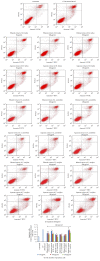Protective Effect of Mangifera indica Linn., Cocos nucifera Linn., and Averrhoa carambola Linn. Extracts against Ultraviolet B-Induced Damage in Human Keratinocytes
- PMID: 27057195
- PMCID: PMC4804050
- DOI: 10.1155/2016/1684794
Protective Effect of Mangifera indica Linn., Cocos nucifera Linn., and Averrhoa carambola Linn. Extracts against Ultraviolet B-Induced Damage in Human Keratinocytes
Abstract
This study was aimed at investigating the antioxidant activity of Mangifera indica Linn., Cocos nucifera Linn., and Averrhoa carambola Linn. and their biological effect on human keratinocytes affected by the ultraviolet B (UVB), a major cause of cell damage and skin cancer through induction of DNA damage, production of reactive oxygen species (ROS), and apoptosis. The richest antioxidant activity was found in ethanol fraction of M. indica (21.32 ± 0.66 mg QE/g dry weight), while the lowest one was found in aqueous fractions of M. indica and C. nucifera (1.76 ± 2.10 and 1.65 ± 0.38 mg QE/g dry weight, respectively). Ethanol and aqueous fractions of A. carambola (250 µg/mL) significantly reduced the number of apoptotic cells. The expression of cleaved caspase 3 in UVB-treated group was significantly greater than that in untreated group. Both fractions of A. carambola (50, 100, and 250 µg/mL) significantly decreased the expression of cleaved caspase 3. Regarding the induction of DNA repair, ethanol (100 and 250 µg/mL) and aqueous (50, 100 and 250 µg/mL) fractions of A. carambola significantly decreased the percentage of cyclobutane pyrimidine dimers (CPD). Taken together, our results suggest that both fractions of A. carambola may be potentially developed for dermal applications.
Figures





References
-
- Nanasombat S., Khanha K., Phan-im J., et al. Antimicrobial and antioxidant activities of Thai local fruit extracts: application of a selected fruit extract. Phyllanthus emblica Linn. as a natural preservative in raw ground pork during refrigerated storage. The Online Journal of Science and Technology. 2012;2(1):1–7.
LinkOut - more resources
Full Text Sources
Other Literature Sources
Research Materials

